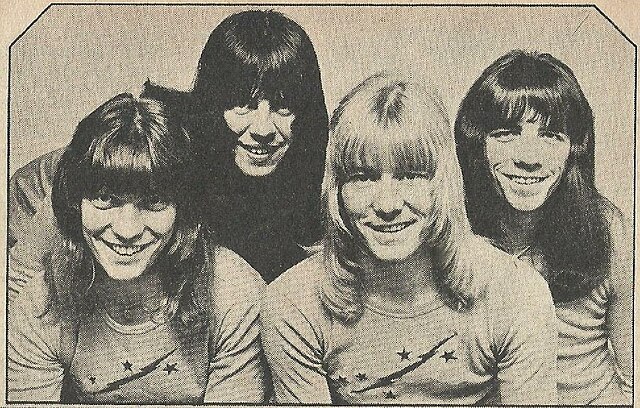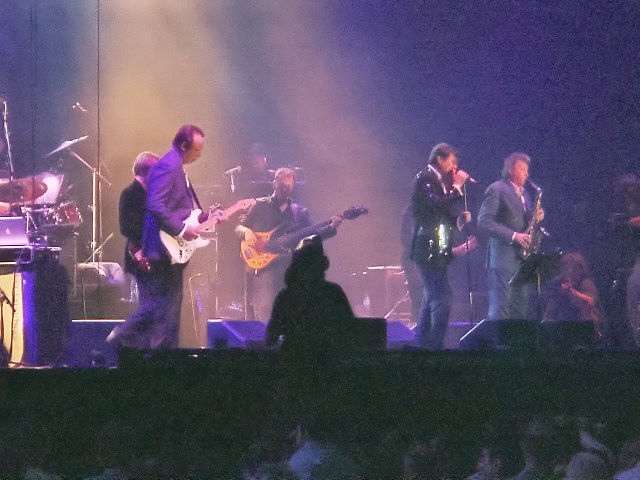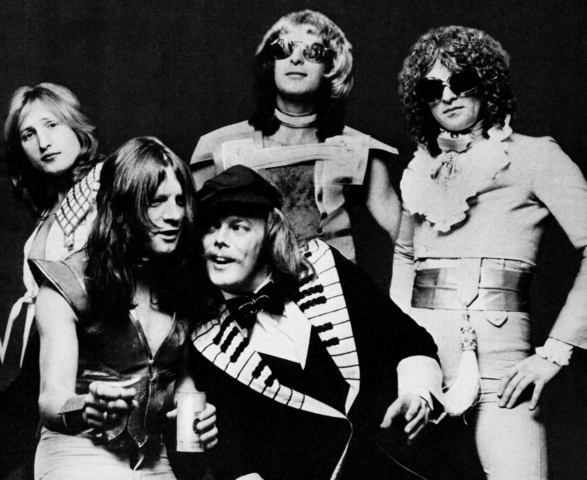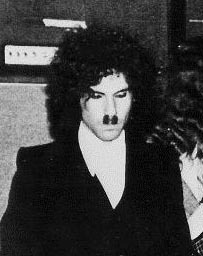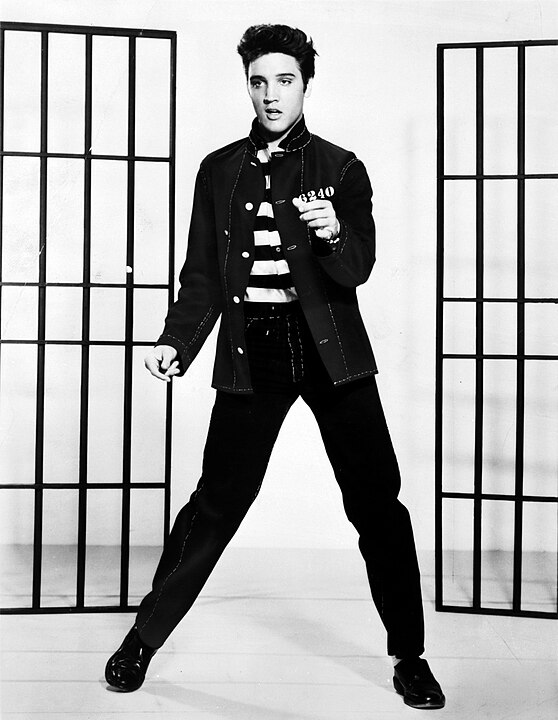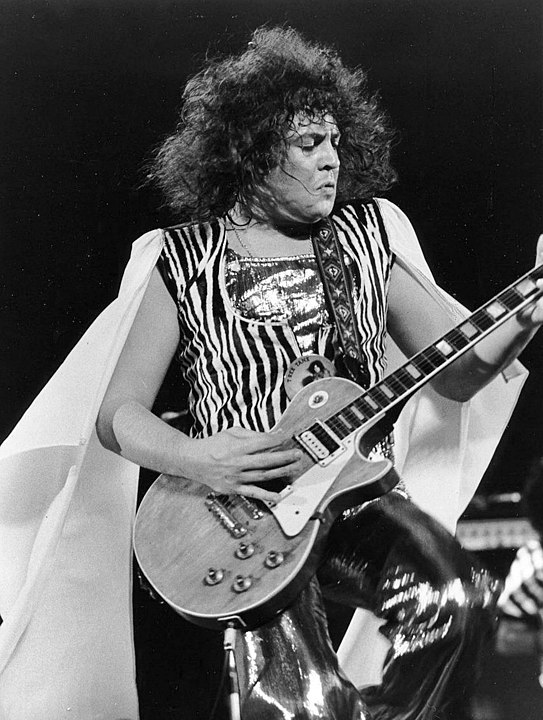Glam rock emerged in the 1970s as a vibrant and theatrical genre. Originating in the UK, it captivated audiences with its flamboyant fashion, energetic performances, and catchy tunes. British glam rock bands of this era not only transformed the music scene but also left an enduring mark on pop culture.
These bands combined bold visual style with unforgettable music, setting the stage for future rock genres. Their influence extended beyond the UK, resonating with fans around the world and shaping the sound of rock music for years to come.
1) David Bowie
David Bowie was a central figure in the glam rock movement of the 70s. His alter ego, Ziggy Stardust, revolutionized music and fashion. Bowie’s 1972 album The Rise and Fall of Ziggy Stardust and the Spiders from Mars is iconic.
Songs like “Starman” and “Suffragette City” showcased his innovative style. Bowie’s onstage persona captivated audiences, pushing boundaries with his unique blend of rock and theatricality.
His influence extended beyond music. Bowie’s bold fashion choices and gender-bending looks challenged societal norms. He inspired countless artists and fans with his fearless creativity and originality.
2) T. Rex
T. Rex, fronted by the charismatic Marc Bolan, played a key role in the glam rock scene of the 1970s. Formed in the late 1960s, the band was originally called Tyrannosaurus Rex. They transitioned from folk rock to glam rock and became widely known for their energetic performances and bold fashion choices.
Marc Bolan’s unique style and stage presence made T. Rex stand out. Hits like “Get It On (Bang a Gong)” and “Children of the Revolution” captivated audiences. These songs, with their catchy riffs and electric sound, helped define the glam rock genre.
The band’s influence extended beyond their music. Their appearance on shows like Top of the Pops, adorned in glitter and flamboyant outfits, set trends and cemented their status as icons of the era. Bolan’s look, including his signature curly hair and feather boas, became synonymous with glam rock.
T. Rex’s popularity in the 70s led to a cultural phenomenon sometimes referred to as “Rextasy,” highlighting their widespread appeal. Their impact on the music scene and pop culture remains significant, marking them as one of the quintessential glam rock bands of their time.
Through their style and sound, T. Rex left an indelible mark on the 70s music landscape. Their contribution to glam rock is celebrated and remembered by fans and musicians alike.
3) Slade
Slade, a rock band from Wolverhampton, England, was formed in 1966. They found their greatest success during the glam rock era of the early 1970s. With a lineup including Noddy Holder, Dave Hill, Jim Lea, and Don Powell, they released memorable hits that dominated the UK charts.
The band is known for their energetic performances and catchy tunes. By blending hard rock, pop, and punk, Slade created a unique sound. They achieved 17 consecutive top 20 hits and six number one singles in the UK.
Their influence extended beyond music. Slade’s flamboyant style, including platform boots and bright costumes, became iconic in the glam rock scene. They paved the way for many bands that followed, shaping the look and sound of the 1970s.
Slade’s music often featured strong beats and infectious melodies. Their song “Cum On Feel the Noize” is one of their most famous tracks, showcasing their powerful and engaging style.
As a significant part of the glam rock movement, Slade’s contributions are still celebrated today. Their impact on music and culture during the 1970s remains a key part of glam rock history.
4) The Sweet
The Sweet, known as The Sweet until the early 1970s, became icons of glam rock during that decade. Formed in London in 1968, the band’s original lineup included lead vocalist Brian Connolly, bassist Steve Priest, guitarist Andy Scott, and drummer Mick Tucker.
One of their first major hits was “Funny, Funny” in 1971. They gained more success with songs like “Little Willy” and “Blockbuster.” The latter became their first number one hit in the UK.
The Sweet’s stage presence and catchy songs helped them become one of the standout bands of the glam rock era. Their flashy outfits and energetic performances captivated audiences. Hits like “Ballroom Blitz” and “Fox on the Run” further cemented their place in rock history.
Despite lineup changes and challenges, The Sweet continued to tour and release music. Their influence can be seen in the glam rock style and sound that followed them. They remain a significant name when discussing the impact of British glam rock in the 70s.
5) Roxy Music
Roxy Music formed in 1970, bringing a unique blend of glam rock and art rock to the music scene. Bryan Ferry, the lead vocalist and principal songwriter, along with bassist Graham Simpson, started the band.
By 1972, they had added Andy Mackay on saxophone and oboe, Phil Manzanera on guitar, Paul Thompson on drums, and Brian Eno on synthesizer.
Roxy Music stood out with their emphasis on style and aesthetics. Ferry’s background in art influenced their distinctive album covers, costumes, and stage presence. Their music combined glam rock’s flamboyance with sophisticated and experimental musicianship.
Their debut album, simply titled “Roxy Music,” set the tone for their innovative approach. Songs like “Virginia Plain” showcased their distinct style. “Avalon,” another of their hits, demonstrated their ability to evolve while still maintaining their core identity.
Roxy Music was a significant influence on the glam rock genre and beyond. They helped shape the sound and look of the 70s glam rock era with their groundbreaking music and visuals. Their impact on later artists and their reunion performances continue to highlight their lasting legacy in rock music.
6) Mott the Hoople
Mott the Hoople was formed in 1969. They started with a heavy, bluesy rock sound. Ian Hunter, the lead singer with big hair and shades, became the face of the band.
Their big break came in 1972 with “All the Young Dudes.” This song, written by David Bowie, became a glam rock anthem. It defined their place in music history.
In 1973, they released the album “Mott.” It was a huge success and cemented their status. Hits like “Honaloochie Boogie” and “All the Way from Memphis” showcased their style.
Mott the Hoople combined catchy melodies with rock ‘n’ roll energy. Their influence is still felt in glam rock today.
7) Gary Glitter
Gary Glitter was a standout figure in the glam rock scene of the 1970s. Known for his flamboyant stage outfits, he quickly became an icon of the genre. His music was characterized by a driving beat and catchy hooks that made his songs undeniably memorable.
One of his most famous tracks, “Rock and Roll (Part 2),” became an anthem and is still widely recognized today. His performances were marked by high energy and theatrics, making him a popular live act.
Glitter’s impact on glam rock was significant. He brought a unique style that combined traditional rock elements with the glam aesthetic. His glittery costumes and bold persona helped to define the image of glam rock during its peak.
Despite his later controversial life, Glitter’s influence on 70s glam rock remains notable. His contribution to the music scene helped to shape the genre and left a lasting legacy in the world of rock music. His songs continue to be a part of the glam rock landscape, remembered for their distinctive style and energy.
8) Mud
Mud was formed in 1966 by four friends in Carshalton, Greater London: Les Gray, Rob Davis, Dave Mount, and Ray Stiles. They started out playing rock and roll cover songs. By 1972, they had secured their first record deal.
Their musical style evolved from rock and roll revival to glam rock. Hits like “Tiger Feet,” their best-selling single in the UK in 1974, showcased their new direction.
Other popular songs included “Dyna-mite” and “Lonely This Christmas,” which hit number one in December 1974. Mud’s songs were marked by a fun, upbeat energy and catchy beats.
Mud played a key role in the glam rock movement of the ’70s. Their success in the charts made them a recognizable name in British music.
9) Wizzard
Wizzard, formed by Roy Wood after his time with The Move and Electric Light Orchestra, was a standout in the glam rock scene of the 70s. Known for their theatrical performances and lavish concerts, Wizzard left a lasting impression in the music world.
Roy Wood’s unique vocal style set the band apart from others. They experimented with blending glam rock with classical music and seasonal cheer. This mix created a distinct sound that was both innovative and entertaining.
One of Wizzard’s most famous contributions to music is their 1973 Christmas single, “I Wish It Could Be Christmas Everyday.” This song remains a beloved holiday classic and continues to be enjoyed by fans each year.
Wizzard’s ability to fuse different musical styles showcased their versatility. Their performances often included a combination of glitter, bold costumes, and elaborate stage setups, embodying the flamboyant spirit of glam rock.
Though their time in the spotlight was relatively brief, Wizzard’s impact on the glam rock movement is undeniable. Their creativity and willingness to push boundaries helped shape the genre during its peak in the 1970s.
10) Sparks
Sparks, formed in 1972, brought a unique twist to the glam rock scene with their quirky style and innovative music. The band was founded by brothers Ron and Russell Mael. Their early work was characterized by quirky lyrics and theatrical performances.
The album Kimono My House, released in 1974, became a defining moment for Sparks. It featured the hit single “This Town Ain’t Big Enough for Both of Us,” which showcased their eclectic sound and unusual lyrics.
Sparks maintained a distinctive image, often blending glam rock with elements of pop, rock, and even electronic music. Their on-stage presence was as memorable as their music, often featuring flamboyant costumes and dynamic performances.
The Mael brothers continued to evolve their sound throughout the 70s, constantly experimenting with new styles while maintaining their identity. Their influence on the glam rock genre is undeniable, and their ability to innovate set them apart from other bands of the era.
Origins of Glam Rock
Glam rock emerged in the early 1970s in the United Kingdom. The style was notable for its theatrics and distinct fashion statements, blending elements from various genres and cultural movements.
Early Influences
Glam rock took inspiration from a diverse array of sources. 1950s rock and roll icons like Little Richard and Elvis Presley influenced its flamboyant style and stage presence. These early performers’ flashy clothing and dynamic performances set a precedent.
1960s psychedelic rock also played a role. Bands like the Beatles experimented with eclectic fashion and creative stage designs. Additionally, David Bowie, with his alter ego Ziggy Stardust, merged music, theater, and visual art, making him a pivotal figure in glam rock.
Cultural Context
The cultural backdrop of the 1970s in Britain was crucial to glam rock’s rise. Post-World War II, the youth were looking for ways to express individuality and challenge traditional norms. Fashion became a vital part of this rebellion.
Glam rock performers often wore androgynous clothing and makeup, questioning societal gender norms. Urbanization and the rise of mass media also played a role. Television and magazines helped spread the glam rock aesthetic quickly, reaching a wide audience and making it a significant cultural phenomenon of its time.
In effect, glam rock became not just a musical genre but a way for young people to explore identity and self-expression.
Impact on Fashion and Culture
Glam rock in the 70s profoundly shifted both fashion and culture. This movement was known for its bold styles and its challenge to societal norms. Its influence is still seen today.
Iconic Looks
Glam rock fashion was characterized by extravagant outfits, heavy makeup, and theatrical accessories. David Bowie, with his Ziggy Stardust persona, set the standard for glam rock style.
Platform shoes and spandex, along with sequins, were staples. Bright colors and glitter were also key elements. Marc Bolan of T. Rex often donned feather boas and glitter-covered attire, emphasizing a flashy and androgynous look.
Band members like those in Slade and Roy Wood embraced flamboyant hairstyles and costumes. Oversized sunglasses and star-shaped face paint were common, adding to the visual spectacle.
Social Impact
Glam rock’s impact extended beyond fashion, greatly influencing societal norms. It challenged traditional gender roles with its embrace of androgyny. Artists like Bowie and Roxy Music blurred the lines between masculinity and femininity, promoting a more fluid expression of identity.
This movement also encouraged a form of escapism. During a time of economic stress and political unrest, glam rock offered an imaginative outlet. Performances were not just concerts but full theatrical productions, which allowed fans to lose themselves in a world of glitter and glamour.
The social impact of glam rock is evident today as artists and fashion designers continue to draw inspiration from its boundary-pushing styles. The fusion of music and fashion that began with glam rock paved the way for future movements, leaving a lasting legacy on popular culture.
